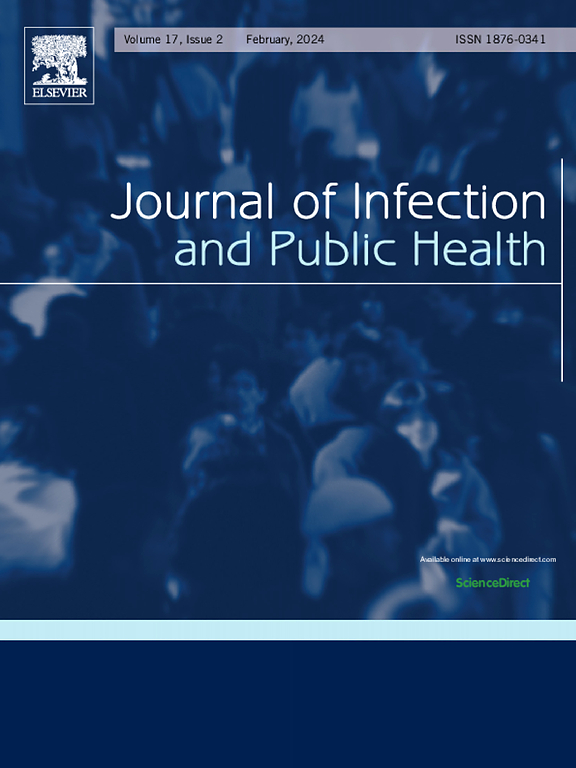评价化学发光免疫分析法检测梅毒:比较分析
IF 4.7
3区 医学
Q1 INFECTIOUS DISEASES
引用次数: 0
摘要
梅毒是由梅毒螺旋体(Treponema pallidum, TP)引起的,仍然是一个重大的全球公共卫生问题,每年约有800万新病例。诊断梅毒是具有挑战性的,因为它往往在潜伏阶段无症状的性质,需要多种诊断方法的组合。本研究评估了迈瑞公司开发的一种用于检测TP抗体的新型化学发光免疫分析法(CLIA)的性能,并将其与广泛使用的雅培ARCHITECT梅毒梅毒螺旋体试验(ARCHITECT -TP)、快速血浆恢复(RPR)试验和Fujiribio innol - lia®梅毒评分线免疫分析法(innol - lia -TP)进行了比较。方法选择180份RPR和Architect-TP检测结果一致或不一致的样品。选取RPR阳性和Architect-TP阳性40例,RPR阳性和Architect-TP阴性40例,RPR和Architect-TP均阴性100例。所有样品均使用Mindray-TP和ino - lia - tp法重新检测。结果mindrray - tp和Architect-TP的灵敏度为100 %(95 % CI: 91 ~ 100),特异度为100 %(95 % CI: 974 ~ 100),与inin - lia - tp具有完美的一致性(κ= 1.00)。其中40例(28.6 %;40/140)与ino - lia - tp相比,使用RPR试验时显示假阳性结果,表明RPR试验的假阳性率很高。结论:本研究强调了Mindray-TP检测的高诊断准确性,将其定位为高容量实验室中梅毒筛查的可靠和高效工具。鉴于其操作效率和与金标准测定法的高度一致性,Mindray-TP可以加强诊断工作流程,从而及时发现梅毒并改善患者预后。本文章由计算机程序翻译,如有差异,请以英文原文为准。
Evaluating chemiluminescent immunoassays for syphilis detection: A comparative analysis
Background
Syphilis, caused by Treponema pallidum (TP), remains a significant global public health concern, with approximately 8 million new cases annually. Diagnosing syphilis is challenging due to its often-asymptomatic nature during latent stages, necessitating a combination of diagnostic methods. This study evaluates the performance of a novel chemiluminescent immunoassay (CLIA) developed by Mindray for detecting TP antibodies, comparing it to the widely used Abbott ARCHITECT Syphilis Treponemal Test (Architect-TP), the rapid plasma regain (RPR) test, and the Fujiribio INNO-LIA® Syphilis Score line immunoassay (INNO-LIA-TP).
Methods
We selected 180 samples that exhibited agreement or discrepancies between the RPR and Architect-TP assays. The selection included 40 cases that were RPR positive and Architect-TP positive, 40 cases that were RPR positive and Architect-TP negative, and 100 cases that were negative in both RPR and Architect-TP. All samples underwent re-testing using the Mindray-TP and INNO-LIA-TP assays.
Results
Mindray-TP and Architect-TP exhibited excellent sensitivity of 100 % (95 % CI: 91–100) and specificity of 100 % (95 % CI: 97.4–100), with perfect agreement (κ= 1.00) compared to INNO-LIA-TP. Notably, 40 cases (28.6 %; 40/140) demonstrated false-positive results when using the RPR test compared to INNO-LIA-TP, indicating a substantial false-positive rate for the RPR assay.
Conclusion
This study highlights the high diagnostic accuracy of the Mindray-TP assay, positioning it as a reliable and efficient tool for syphilis screening in high-volume laboratories. Given its operational efficiency and strong agreement with gold-standard assays, Mindray-TP can enhance diagnostic workflows, leading to timely syphilis detection and improved patient outcomes.
求助全文
通过发布文献求助,成功后即可免费获取论文全文。
去求助
来源期刊

Journal of Infection and Public Health
PUBLIC, ENVIRONMENTAL & OCCUPATIONAL HEALTH -INFECTIOUS DISEASES
CiteScore
13.10
自引率
1.50%
发文量
203
审稿时长
96 days
期刊介绍:
The Journal of Infection and Public Health, first official journal of the Saudi Arabian Ministry of National Guard Health Affairs, King Saud Bin Abdulaziz University for Health Sciences and the Saudi Association for Public Health, aims to be the foremost scientific, peer-reviewed journal encompassing infection prevention and control, microbiology, infectious diseases, public health and the application of healthcare epidemiology to the evaluation of health outcomes. The point of view of the journal is that infection and public health are closely intertwined and that advances in one area will have positive consequences on the other.
The journal will be useful to all health professionals who are partners in the management of patients with communicable diseases, keeping them up to date. The journal is proud to have an international and diverse editorial board that will assist and facilitate the publication of articles that reflect a global view on infection control and public health, as well as emphasizing our focus on supporting the needs of public health practitioners.
It is our aim to improve healthcare by reducing risk of infection and related adverse outcomes by critical review, selection, and dissemination of new and relevant information in the field of infection control, public health and infectious diseases in all healthcare settings and the community.
 求助内容:
求助内容: 应助结果提醒方式:
应助结果提醒方式:


